History of Armenia

| History ofArmenia |
|---|
 |
| Timeline•Origins•Etymology |
Thehistory of Armeniacovers the topics related to the history of theRepublic of Armenia,as well as theArmenian people,theArmenian language,and the regions ofEurasiahistorically andgeographicallyconsideredArmenian.[1]
Armeniais located betweenEastern Anatoliaand theArmenian highlands,[1]surrounding the Biblical mountains ofArarat.Theendonymof the Armenians ishay,and the oldArmenianname for the country isHayk'(Armenian:Հայք,which also means "Armenians" inClassical Armenian), laterHayastan(Armenian:Հայաստան).[1]Armenians traditionally associate this name with the legendary progenitor of the Armenian people,Hayk.The names Armenia and Armenian areexonyms,first attested in theBehistun InscriptionofDarius the Great.The early Armenian historianMovses Khorenatsiderived the name Armenia from Aramaneak, the eldest son of the legendary Hayk.[2]Various theories exist about the origin of the endonym and exonyms of Armenia and Armenians (seeName of Armenia).
In theBronze Age,several states flourished in theArmenian highlands,including theHittite Empire(at the height of its power),Mitanni(southwestern historical Armenia), andHayasa-Azzi(1600–1200 BC). Soon after the Hayasa-Azzi were theNairi tribal confederation(1400–1000 BC) and theKingdom of Urartu(1000–600 BC). Each of the aforementioned nations and tribes participated in theethnogenesisof theArmenian people.[3][4]Yerevan,the modern capital of Armenia, dates back to the 8th century BC, with the founding of the fortress ofErebuniin 782 BC by KingArgishti Iat the western extreme of theArarat plain.[5]Erebuni has been described as "designed as a great administrative and religious centre, a fully royal capital."[6]
The Iron Age kingdom ofUrartuwas replaced by theOrontid dynasty,which ruled Armenia first assatrapsunderAchaemenid Persianrule and later as independent kings.[7][8]Following Persian and subsequent Macedonian rule, theKingdom of Greater Armeniawas established in 190 BC byArtaxias I,founder of theArtaxiad dynasty.The Kingdom of Armenia rose to the peak of its influence in the 1st century BC underTigranes the Greatbefore falling under Roman suzerainty.[9]In the 1st century AD, a branch of the rulingArsacid dynastyof theParthian Empireestablished itself on the throne of Armenia.
In the early 4th century,Arsacid Armeniabecame the first state to acceptChristianityas itsstate religion.The Armenians later fell underByzantine,Sassanid Persian,andIslamichegemony, but reinstated their independence with theBagratid kingdom of Armeniain the 9th century. After the fall of the kingdom in 1045, and the subsequent Seljuk conquest of Armenia in 1064, the Armenians established a kingdom inCilicia,which existed until its destruction in 1375.[10]
In the early 16th century, much of Armenia came underSafavid Persianrule; however, over the centuriesWestern Armeniafell underOttomanrule, whileEastern Armeniaremained under Persian rule.[11]By the 19th century, Eastern Armenia was conquered by Russia and Greater Armenia was divided between the Ottoman and Russian empires.[12]
In the early 20th century, the Ottoman government subjected the Armenians to agenocidein which up to 1.5 million Armenians were killed and many morewere dispersedthroughout the world viaSyriaandLebanon.In 1918, an independentRepublic of Armeniawas established in Eastern Armenia in the wake of the collapse of theRussian Empire.This republic fell under Soviet rule in 1920, and Armenia became arepublicwithin theSoviet Unionafter its founding. In 1991, with thedissolution of the Soviet Union,the modern-day independentRepublic of Armeniawas established.[13][14][15]
Prehistory
Stone tools from 325,000 years ago have been found in Armenia which indicate the presence of early humans at this time.[16]
In the 1960s, excavations in the Yerevan 1 Cave uncovered evidence of ancient human habitation, including the remains of a 48,000-year-old heart, and a human cranial fragment and tooth of a similar age.[citation needed]
TheArmenian Highlandshows traces of settlement from theNeolithicera. Archaeological surveys in 2010 and 2011 have resulted in the discovery of the world's earliest known leather shoe (3,500 BC), straw skirt (3,900 BC), and wine-making facility (4,000 BC) at theAreni-1 cave complex.[17][18][19]

TheShulaveri-Shomu cultureof the centralTranscaucasusregion is one of the earliest known prehistoric cultures in the area, carbon-dated to roughly 6000–4000 BC.[citation needed]
Bronze Age
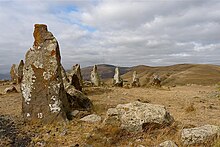
An early Bronze-Age culture in the area is theKura-Araxes culture,assigned to the period between c. 4000 and 2200 BC. The earliest evidence for this culture is found on theArarat plain;thence it spread toGeorgiaby 3000 BC (but never reachingColchis), proceeding westward and to the south-east into an area below the Urmia basin andLake Van.
From 2200 BC to 1600 BC, theTrialeti-Vanadzor cultureflourished in Armenia, southern Georgia, and northeastern Turkey.[20][21]It has been speculated that this was an Indo-European culture.[22][23][24]Other, possibly related, cultures were spread throughout the Armenia Highlands during this time, namely in theAragatsandLake Sevanregions.[25][26][27]
Early 20th-century scholars suggested that the name "Armenia" may have possibly been recorded for the first time on an inscription which mentionsArmanî(or Armânum) together withIbla,from territories conquered byNaram-Sin(2300 BC) identified with anAkkadiancolony in the current region ofDiyarbekir;however, the precise locations of both Armani and Ibla are unclear. Some modern researchers have placed Armani (Armi) in the general area of modernSamsat,[28]and have suggested it was populated, at least partially, by an early Indo-European-speaking people.[29]Today, theModern Assyrians(who traditionally speakNeo-Aramaic,notAkkadian) refer to the Armenians by the name Armani.[30]It is possible that the nameArmeniaoriginates inArmini,Urartian for "inhabitant of Arme" or "Armean country."[31]The Arme tribe of Urartian texts may have been the Urumu, who in the 12th century BC attempted to invade Assyria from the north with their allies theMushkiand theKaskians.The Urumu apparently settled in the vicinity ofSason,lending their name to the regions of Arme and the nearby land of Urme.[32]Thutmose IIIofEgypt,in the 33rd year of his reign (1446 BC), mentioned as the people of "Ermenen", claiming that in their land "heaven rests upon its four pillars".[33]Armenia is possibly connected toMannaea,which may be identical to the region of Minni mentioned inThe Bible.However, what all these attestations refer to cannot be determined with certainty, and the earliest certain attestation of the name "Armenia" comes from theBehistun Inscription(c. 500 BC).
The earliest form of the word "Hayastan", anendonymfor Armenia, might possibly beHayasa-Azzi,a kingdom in the Armenian Highlands that was recorded inHittiterecords dating from 1500 to 1200 BC.
Between 1200 and 800 BC, much of Armenia was united under a confederation of tribes, which Assyrian sources calledNairi( "Land of Rivers" in Assyrian ").[34]
Iron Age


The Kingdom of Urartu, also known as the Kingdom of Van, flourished between the 9th century BC[35]and 585 BC[36]in theArmenian Highland.The founder of the Urartian Kingdom,Aramé,united all the principalities of the Armenian Highland and gave himself the title "King of Kings", the traditional title of Urartian Kings.[37]The Urartians established their sovereignty over all ofTaronandVaspurakan.The main rival of Urartu was theNeo-Assyrian Empire.[38]
During the reign ofSarduri I(834–828 BC), Urartu had become a strong and organized state, and imposed taxes on neighbouring tribes. Sarduri madeTushpa(modernVan) the capital of Urartu. His son,Ishpuinis,extended the borders of the state by conquering what would later be known as theTigranocertaarea and by reachingUrmia.Menuas(810–785 BC) extended the Urartian territory up north, by spreading towards the Araratian fields. He left more than 90 inscriptions by using the Mesopotamiancuneiformwriting system in theUrartian language.Argishtis I of UrartuconqueredLatakiafrom the Hittites,[citation needed]and reachedByblos,[citation needed]andPhoenicia.[citation needed]He built theErebuni Fortress,located in modern-dayYerevan,in 782 BC by using 6600 prisoners of war.[citation needed]
In 714 BC, theAssyriansunderSargon IIdefeated the Urartian KingRusa IatLake Urmiaand destroyed the holy Urartian temple atMusasir.At the same time, anIndo-Europeantribe called theCimmeriansattacked Urartu from the north-west region and destroyed the rest of his armies. UnderAshurbanipal(669–627 BC) the boundaries of theAssyrian Empirereached as far as Armenia and the Caucasus Mountains. TheMedesunderCyaxaresinvaded Assyria later on in 612 BC, and then took over the Urartian capital ofVantowards 585 BC, effectively ending the sovereignty of Urartu.[39]According to the Armenian tradition, the Medes helped the Armenians establish theOrontiddynasty.[40]
Antiquity
Orontid dynasty
After the fall of Urartu around 585 BC, theSatrapy of Armeniaarose, ruled by the ArmenianOrontid Dynasty,which governed the state in 585–190 BC. Under the Orontids, Armenia during this era was asatrapyof thePersian Empire,and after its disintegration (in 330 BC), it became an independent kingdom. During the rule of the Orontid dynasty, most Armenians adopted theZoroastrianreligion.[41]


Artaxiad dynasty
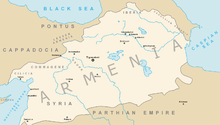
The HellenisticSeleucid Empire,controlled Syria, Armenia, and vast other eastern regions. However, after their defeat by Rome in 190 BC, the Seleucids relinquished control of any regional claim past the Taurus Mountains, limiting Seleucids to a quickly diminishing area of Syria. A Hellenistic Armenian state was founded in 190 BC. It was aHellenisticsuccessor state ofAlexander the Great's short-lived empire, with Artaxias becoming its first king and the founder of the Artaxiad dynasty (190 BC–AD 1). At the same time, a western portion of the kingdom split as a separate state under Zariadris, which became known asLesser Armeniawhile the main kingdom acquired the name ofGreater Armenia.[36]
The new kings began a program of expansion which was to reach its zenith a century later. Their acquisitions are summarized by Strabo. Zariadris acquiredAciliseneand the "country around the Antitaurus", possibly the district of Muzur or west of theEuphrates.Artaxias took lands from the Medes, Iberians, and Syrians. He then had confrontations withPontus,Seleucid Syria and Cappadocia, and was included in the treaty which followed the victory of a group of Anatolian kings over Pharnaces of Pontus in 181 BC. Pharnaces thus abandoned all of his gains in the west.[42]
At its zenith, from 95 to 66 BC, Greater Armenia extended its rule over parts of the Caucasus and the area that is now eastern and centralTurkey,north-westernIran,Israel,SyriaandLebanon,forming the second Armenian empire. For a time, Armenia was one of the most powerful states east of Rome. It eventually confronted theRoman Republicin wars, which it lost in 66 BC, but nonetheless preserved its sovereignty. Tigranes continued to rule Armenia as an ally of Rome until his death in 55 BC.[43]
TheThird Mithridatic Warand defeat of the King of Pontus by RomanPompeiusresulted in the Kingdom of Armenia becoming an allied client state of Rome. Later on, in 1 AD, Armenia came under fullRomancontrol until the establishment of the Armenian Arsacid dynasty. The Armenian people then adopted a Western political, philosophical, and religious orientation. According to Strabo, around this time everyone in Armenia spoke "the same language."[44]
Roman Armenia
This sectionneeds additional citations forverification.(December 2015) |
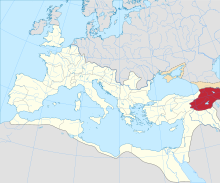
FromPompeius' campaign Armenia was, for the next few centuries, contested between Rome and Parthia/Sassanid Persia on the other hand. Roman emperorTrajaneven created a short-lived Province of Armenia between 114 and 118 AD.[45]
Indeed, Roman supremacy was fully established by thecampaignsofGnaeus Domitius Corbulo,[46]that ended with a formal compromise: a Parthian prince of theArsacidline would henceforth sit on the Armenian throne, but his nomination had to be approved by the Roman emperor.
Because this agreement was not respected by the Parthian Empire, in 114TrajanfromAntiochiain Syria marched on Armenia and conquered the capitalArtaxata.Trajan then deposed the Armenian kingParthamasiris(imposed by the Parthians) and ordered the annexation of Armenia to the Roman Empire as a new province. The new province reached the shores of theCaspian Seaand bordered to the north withCaucasian IberiaandCaucasian Albania,two vassal states of Rome. As a Roman province Armenia was administered by Catilius Severus of theGens Claudia.After Trajan's death, however, his successorHadriandecided not to maintain the province of Armenia. In 118 AD, Hadrian gave Armenia up, and installedParthamaspatesas its "vassal" king.
Arsacid dynasty

Armenia, under itsArshakuni dynasty,which was a branch of the eponymous Arsacid dynasty of Parthia, was often a focus of contention between Rome and Parthia.[47]The Parthians forced Armenia into submission from 37 to 47, when the Romans retook control of the kingdom.
UnderNero,the Romans fought acampaign (55–63)against theParthian Empire,which had invaded the kingdom of Armenia, allied to the Romans. After gaining (60) and losing (62) Armenia, the Romans underGnaeus Domitius Corbulo,legateofSyriaentered (63) into an agreement ofVologases I of Parthia,which confirmedTiridates Ias king of Armenia, thus founding the Arshakuni dynasty.
The Arsacid dynasty lost control of Armenia for a few years when emperorTrajancreated the "Roman Province of Armenia", fully included into theRoman Empirefrom 114 to 117 AD. His successor,Hadrian,reinstalled the Arsacid Dynasty when he nominatedParthamaspatesas "vassal" king of Armenia in 118 AD.
Another campaign was led by EmperorLucius Verusin 162–165, afterVologases IVof Parthia had invaded Armenia and installed his chief general on its throne. To counter the Parthian threat, Verus set out for the east. His army won significant victories and retook the capital.Sohaemus,a Roman citizen of Armenian heritage, was installed as the newclient king.[48]
TheSassanidPersians occupied Armenia in 252 and held it until the Romans returned in 287. In 384 the kingdom was split between theByzantine Empireand the Persians.[49]Western Armenia quickly became a province of the Roman Empire under the name ofArmenia Minor;Eastern Armenia remained a kingdom within Persia until 428, when the local nobility overthrew the king, and the Sassanids installed a governor in his place.
According to tradition, theArmenian Apostolic Churchwas established by two of Jesus'twelve apostles—ThaddaeusandBartholomew— who preached Christianity in Armenia in the 40s—60s AD.[50]Between 1st and 4th centuries AD, the Armenian Church was headed by patriarchs.
Christianization

In 301, Armenia became the first nation to adoptChristianityas a state religion,[54]amidst the long-lasting geo-political rivalry over the region. It established a church that today exists independently of both theCatholicand theEastern Orthodoxchurches, having become so in 451 after having rejected theCouncil of Chalcedon.[55]TheArmenian Apostolic Churchis a part of theOriental Orthodoxcommunion, not to be confused with the Eastern Orthodox communion. The firstCatholicosof the Armenian church was SaintGregory the Illuminator.[56]Because of his beliefs, he was persecuted by the pagan king of Armenia, and was "punished" by being thrown inKhor Virap,in modern-day Armenia.[57]
He acquired the title of Illuminator, because he illuminated the spirits of Armenians by introducing Christianity to them. Before this, the dominant religion amongst the Armenians wasZoroastrianism.[58]Scholars have suggested that Armenia adopted Christianity "partly... in defiance" of the Sassanids.[59]
In 405–06, Armenia's political future seemed uncertain. With the help of the King of Armenia,Mesrop Mashtotscreated a unique alphabet to suit the people's needs.[clarification needed][60]By doing so, he ushered in a newGolden Ageand strengthened Armenian national identity.[citation needed]
After years of rule, the Arsacid dynasty fell in 428, with Eastern Armenia being subjugated to Persia and Western Armenia, to Rome. In the 5th century, the Sassanid ShahYazdegerd IItried to tie his Christian Armenian subjects more closely to the Sassanid Empire by reimposing the Zoroastrian religion.[61]The Armenians greatly resented this, and as a result, a rebellion broke out with Vartan Mamikonian as the leader of the rebels. Yazdegerd thus massed his army and sent it to Armenia, where theBattle of Avarayrtook place in 451. The 66,000 Armenian rebels,[62]mostly peasants, lost their morale when Mamikonian died in the battlefield. They were substantially outnumbered by the 180,000- to 220,000-strong[63]Persian army ofImmortalsandwar elephants.Despite being a military defeat, the Battle of Avarayr and the subsequent guerilla war in Armenia eventually resulted in the Treaty of Nvarsak (484), which guaranteed religious freedom to the Armenians.[64]
Persian Armenia
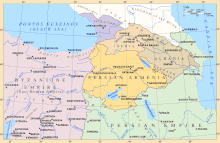
With the partition of Armenia in 387 by the Byzantines andSassanids,the western half became part of the Byzantines known asByzantine Armenia,while the eastern (and much larger half) became a vassal state within the Sassanid realm.[65]
In 428, theArsacid dynasty of Armeniawas completely abolished by the Sassanid Persians, and the territory was made a full province within Persia, known asPersian Armenia.[65]Persian Armenia remained in Sassanid hands up to theMuslim conquest of Persia,when the invading Muslim forces annexed the Sassanid realm.[66]
Middle Ages
This sectionneeds additional citations forverification.(December 2015) |
Arab Caliphates, Byzantium and Bagratid Armenia

In 591, the Byzantine EmperorMauricedefeated the Persians and recovered much of the remaining territory of Armenia into the empire.[67]The conquest was completed by the EmperorHeraclius,himself ethnically Armenian,[68][69][70]in 629. In 645, the Muslim Arab armies of theCaliphatehadattacked and conquered the country.Armenia, which once had its own rulers and was at other times under Persian and Byzantine control, passed largely into the power of the Caliphs, and established the province ofArminiya.
Nonetheless, there were still parts of Armenia held within the Empire, containing many Armenians. This population held tremendous power within the empire. EmperorHeraclius(610–641) was of Armenian descent, as was EmperorPhilippikos Bardanes(711–713). The EmperorBasil I,who took the Byzantine throne in 867, was the first of what is sometimes called the Armenian dynasty (seeMacedonian dynasty), reflecting the strong effect the Armenians had on theByzantine Empire.[71]
Evolving as a feudal kingdom in the ninth century, Armenia experienced a brief cultural, political and economic renewal under theBagratuni dynasty.Bagratid Armeniawas eventually recognized as a sovereign kingdom by the two major powers in the region: Baghdad in 885, and Constantinople in 886.Ani,the new Armenian capital, was constructed at the Kingdom's apogee in 964.[72]
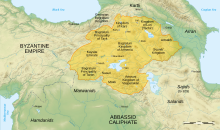
Sallarid dynasty
TheIranian[73][74]Sallarid dynastyconquered parts of Eastern Armenia in the second half of the 10th century.[75]
Seljuq Armenia

Although the native Bagratuni dynasty was founded under favourable circumstances, the feudal system gradually weakened the country by eroding loyalty to the central government. Thus internally enfeebled, Armenia proved an easy victim for the Byzantines, who captured Ani in 1045. TheSeljuk dynastyunderAlp Arslanin turn took the city in 1064.[77]
In 1071, after the defeat of the Byzantine forces by the Seljuk Turks at theBattle of Manzikert,the Turks captured the rest of Greater Armenia and much ofAnatolia.[78]So ended Christian leadership of Armenia for the next millennium with the exception of a period of the late 12th-early 13th centuries, when the Muslim power in Greater Armenia was seriously troubled by the resurgentKingdom of Georgia.Many local nobles (nakharars) joined their efforts with theGeorgians,leading to liberation of several areas in northern Armenia, which was ruled, under the authority of the Georgian crown, by theZakarids-Mkhargrzeli,a prominent Armeno-Georgian noble family.
Mongol Armenia
TheMongol invasions of Armenia and Georgiabrought a lot of devastation, but severalArmenian dynastiesof the 13th–14th century CE also managed to prosper as allies of the Mongols, such as theZakarians,theOrbeliansor theProshyans.[79]They benefited from trade routes to China under the control of the Mongols, and their prosperity led them to build many magnificent churches and monasteries, such asSpitakavor Astuatsatsin.[79][80]
Armenian Kingdom of Cilicia
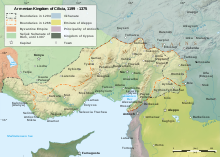
To escape death or servitude at the hands of those who had assassinated his relative,Gagik II,King ofAni,an Armenian namedRoupenwith some of his countrymen went into the gorges of the Taurus Mountains and then into Tarsus of Cilicia. Here the Byzantine governor gave them shelter in the late 11th century. Two great dynastic families, theRubenidsand theHethumids,ruled what became in 1199, with the coronation ofLevon I,theArmenian Kingdom of Ciliciaand through skillful diplomacy and military alliances (explained below) maintained their political autonomy until 1375.[81]The kingdom's political independence relied on a vast network of castles which controlled the mountain passes and the strategic harbours.[82]Almost all of the civilian settlements were located directly below or near these fortifications.[83]
After the members of the first Crusade appeared in Asia Minor, the Armenians developed close ties to EuropeanCrusader States.They flourished in south-easternAsia Minoruntil it was conquered byMuslimstates. CountBaldwin,who with the rest of the Crusaders was passing through Asia Minor bound for Jerusalem, left the Crusader army and was adopted byThoros of Edessa,an Armenian ruler of Greek Orthodox faith.[84]As they were hostile towards theSeljuksand unfriendly to the Byzantines, the Armenians took kindly to the crusader count. So when Thoros was assassinated, Baldwin was made ruler of the new crusaderCounty of Edessa.It seems that the Armenians were pleased with Baldwin's rule and with the crusaders in general, and some number of them fought alongside the crusaders. WhenAntiochhad been taken (1097), Constantine, the son of Roupen, received from the crusaders the title of baron.[85]
TheThird Crusadeand other events elsewhere left Cilicia as the sole substantial Christian presence in the Middle East.[84]World powers, such as Byzantium, the Holy Roman Empire, the Papacy and even theAbbasidCaliph competed and vied for influence over the state and each raced to be the first to recogniseLeo II,Prince of Lesser Armenia, as the rightful king. As a result, he had been given a crown by both German and Byzantine emperors. Representatives from across Christendom and a number of Muslim states attended the coronation, thus highlighting the important stature that Cilicia had gained over time.[84]The Armenian authorities was often in touch with the crusaders. No doubt the Armenians aided in some of the other crusades. Cilicia flourished greatly under Armenian rule, as it became the last remnant of Medieval Armenian statehood.[86]Cilicia acquired an Armenian identity, as the kings of Cilicia were called kings of the Armenians, not of the Cilicians.
In Lesser Armenia, Armenian culture was intertwined with both the European culture of the Crusaders and with the Hellenic culture of Cilicia. As the Catholic families extended their influence over Cilicia, the Pope wanted the Armenians to follow Catholicism. This situation divided the kingdom's inhabitants between pro-Catholic and pro-Apostolic camps. Armenian sovereignty lasted until 1375, when the Mamelukes of Egypt profited from the unstable situation in Lesser Armenia and destroyed it.[87]
Early Modern period
Persian Armenia
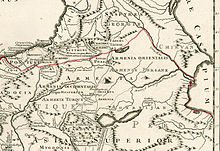

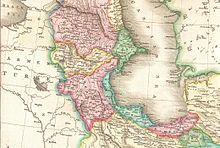

Due to its strategic significance, the historical Armenian homelands ofWestern ArmeniaandEastern Armeniawere constantly fought over and passed back and forth betweenSafavid Persiaand theOttomans.For example, at the height of theOttoman–Persian Wars,Yerevan changed hands fourteen times between 1513 and 1737. Greater Armenia was annexed in the early 16th century by ShahIsmail I.[88]Following thePeace of Amasyaof 1555, Western Armenia fell into the neighbouringOttoman hands,while Eastern Armenia stayed part of Safavid Iran, until the 19th century.[citation needed]
In 1604,Shah Abbas Ipursued a scorched-earth campaign against the Ottomans in the Ararat valley during theOttoman–Safavid War (1603–1618).The old Armenian town ofJulfain the province ofNakhichevanwas taken early in the invasion. From there Abbas' army fanned out across the Araratian plain. The Shah pursued a careful strategy, advancing and retreating as the occasion demanded, determined not to risk his enterprise in a direct confrontation with stronger enemy forces.
While laying siege toKars,he learned of the approach of a large Ottoman army, commanded by DjghazadéSinan Pasha.The order to withdraw was given; but to deny the enemy the potential to resupply themselves from the land, he ordered the wholesale destruction of the Armenian towns and farms on the plain. As part of this the whole population was ordered to accompany the Persian army in its withdrawal. Some 300,000 people were duly herded to the banks of theAraxes River.Those who attempted to resist themass deportationwere killed outright. The Shah had previously ordered the destruction of the only bridge, so people were forced into the waters, where a great many drowned, carried away by the currents, before reaching the opposite bank. This was only the beginning of their ordeal. One eye-witness, Father de Guyan, describes the predicament of the refugees thus:
- It was not only the winter cold that was causing torture and death to the deportees. The greatest suffering came from hunger. The provisions which the deportees had brought with them were soon consumed... The children were crying for food or milk, none of which existed, because the women's breasts had dried up from hunger... Many women, hungry and exhausted, would leave their famished children on the roadside, and continue their tortuous journey. Some would go to nearby forests in search of something to eat. Usually they would not come back. Often those who died, served as food for the living.
Unable to maintain his army on the desolate plain, Sinan Pasha was forced to winter inVan.Armies sent in pursuit of the Shah in 1605 were defeated, and by 1606 Abbas had regained all of the territory lost to the Turks earlier in his reign. The scorched-earth tactic had worked, though at a terrible cost to the Armenian people. Of the 300,000 deported it is calculated that less than half survived the march toIsfahan.In the conquered territories Abbas established theErivan Khanate,a Muslim principality under the dominion of theSafavid Empire.Armenians formed less than 20% of its population[89]as a result ofShah Abbas I's deportation of many of the Armenian population from the Ararat valley and the surrounding region in 1605.[90]
An often-used policy by the Persians was the appointment of Turks as local rulers as so calledkhansof their variouskhanates.These were counted as subordinate to thePersian Empire.Examples include: theKhanate of Erevan,Khanate of Nakhichevanand theKarabakh Khanate.
Even though Western Armenia had already once been conquered by the Ottomans following the Peace of Amasya, Greater Armenia was eventually decisively divided between the vying rivals, the Ottomans and the Safavids, in the first half of the 17th century following theOttoman–Safavid War (1623–1639)and the resultingTreaty of Zuhabunder which Eastern Armenia remained under Persian rule, and Western Armenia remained under Ottoman rule.[11]
Persia continued to rule Eastern Armenia, which included all of the modern-day Armenian Republic, until the first half of the 19th century. By the late 18th century, Imperial Russia had started to encroach to the south into the land of its neighbours;Qajar Iranand Ottoman Turkey. In 1804,Pavel Tsitsianovinvadedthe Iranian town ofGanjaand massacred many of its inhabitants while making the rest flee deeper within the borders of Qajar Iran. This was a declaration of war and regarded as an invasion of Iranian territory.[91]It was the beginning of theRusso-Persian War (1804–1813).The following years were devastating for the Iranian towns in the Caucasus as well as the inhabitants of the region, as well as for the Persian army. The war eventually ended in 1813 with a Russian victory after their successfulstorming of Lankaranin early 1813. TheTreaty of Gulistanthat was signed in the same year forced Qajar Iran to irrevocably cede significant amounts of itsCaucasianterritories to Russia, comprising modern-dayDagestan,Georgia,and most of what is today theRepublic of Azerbaijan.[92][93]Karabakhwas also ceded to Russia by Persia.[93]
The Persians were severely dissatisfied with the outcome of the war which led to the ceding of so much Persian territory to the Russians. As a result,[94]the next war between Russia and Persia was inevitable, namely theRusso-Persian War (1826–1828).However, this war ended even more disastrously, as the Russians not only occupied as far asTabriz,the ensuing treaty that followed, namely theTreaty of Turkmenchayof 1828, forced it to irrevocably cede its last remaining territories in theCaucasus,comprising all of modern-day Armenia,NakhchivanandIğdır Province.[95]
By 1828, Persia had lost Eastern Armenia, which included the territory of the modern-day Armenian Republic after centuries of rule. From 1828 until 1991, Eastern Armenia would entera Russian dominated chapter.Following Russia's conquest of all ofQajar Iran'sCaucasian territories, many Armenian families were encouraged to settle in the newly conquered Russian territories.[citation needed][96]
Ottoman Armenia
This sectionrelies largely or entirely on asingle source.(December 2015) |


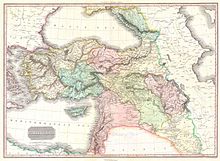
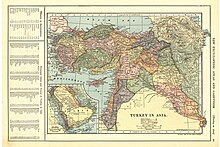
Mehmed IIconqueredConstantinoplefrom the Byzantines in 1453, and made it the Ottoman Empire's capital. Mehmed and his successors used the religious systems of their subject nationalities as a method of population control, and so Ottoman Sultans invited an Armenian archbishop to establish theArmenian Patriarchate of Constantinople.The Armenians of Constantinople grew in numbers, and became respected, if not full, members of Ottoman society.
The Ottoman Empire ruled in accordance toIslamic law.As such, thePeople of the Book(theChristiansand theJews) had to pay an extra tax to fulfil their status asdhimmiand in return were guaranteed religious autonomy. While the Armenians ofConstantinoplebenefited from theSultan's support and grew to be a prospering community, the same could not be said about the ones inhabitinghistoric Armenia.
During times of crisis the ones in the remote regions of mountainouseastern Anatoliawere mistreated by localKurdishchiefs and feudal lords. They often also had to suffer (alongside the settled Muslim population) raids by nomadic Kurdish tribes.[97]Armenians, like the other Ottoman Christians (though not to the same extent), had to transfer some of their healthy male children to the Sultan's government due to thedevşirmepolicies in place. The boys were then forced to convert to Islam (by threat of death otherwise) and educated to be fierce warriors in times of war, as well asBeys,Pashasand evenGrand Viziersin times of peace.[citation needed]
The Armenian national liberation movement was the Armenian effort to free thehistoric Armenian homelandof easternAnatoliaandTranscaucasusfromRussianand Ottoman domination and re-establish the independent Armenian state. The national liberation movement of theBalkan peoplesand the immediate involvement of the European powers in the Eastern question had a powerful effect on the development of the national liberation ideology movement among theArmenians of the Ottoman Empire.[98]
The Armenian national movement, besides its individual heroes, was an organized activity represented around three parties of Armenian people,Social Democrat Hunchakian Party,ArmenakanandArmenian Revolutionary Federation,which ARF was the largest and most influential among the three. Those Armenians who did not support national liberation aspirations or who were neutral were calledchezoks.In 1839, the situation of the Ottoman Armenians slightly improved afterAbdul Mejid Icarried outTanzimatreforms in its territories. However, later Sultans, such asAbdul Hamid IIstopped the reforms and carried out massacres, now known as theHamidian massacresof 1895–96 leading to a failed Armenian attempt toassassinatehim.[99]
Russian Armenia

In the aftermath of theRusso-Persian War, 1826–1828,the parts of historic Armenia (also known asEastern Armenia) under Persian control, centering onYerevanandLake Sevan,were incorporated intoRussiaafter Qajar Persia's forced ceding in 1828 per theTreaty of Turkmenchay.[100]Under Russian rule, the area corresponding approximately to modern-day Armenian territory was called "Province of Yerevan". The Armenian subjects of theRussian Empirelived in relative safety, compared to their Ottoman kin, albeit clashes withTatarsandKurdswere frequent in the early 20th century.[citation needed]Even though Russian Armenians benefited from the advanced Russian culture, and greater access to European thought, and broader economic initiative, they were denied equal educational and administrative opportunities like many other racial and religious minorities.[101]
The Treaty of Turkmenchay of 1828 had further stipulated the rights of the Russian Tsar to resettlePersian Armenianswithin the newly conquered Caucasus region, which had been taken over fromIran.Following the resettlement of Persian Armenians alone in the newly conquered Russian territories, significant demographic shifts were bound to take place. The Armenian-American historianGeorge Bournoutiangives a summary of the ethnic make up after those events:[102]
In the first quarter of the 19th century the Khanate of Erevan included most of Eastern Armenia and covered an area of approximately 7,000 square miles [18,000 km2]. The land was mountainous and dry, the population of about 100,000 was roughly 80 percent Muslim (Persian, Azeri, Kurdish) and 20 percent Christian (Armenian).
After the incorporation of theErivan Khanateinto the Russian Empire, Muslim majority of the area gradually changed, at first the Armenians who were left captive were encouraged to return.[103]As a result of which an estimated 57,000 Armenian refugees from Persia returned to the territory of the Erivan Khanate after 1828, while about 35,000 Muslims (Persians, Turkic groups, Kurds, Lezgis, etc.) out of a total population of over 100,000 left the region.[104]
20th century
The Armenian genocide (1915–1921) and First World War

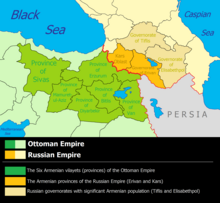

In 1915, the Ottoman Empire systematically carried out theArmenian genocide.This genocide was preceded by awave of massacresin the years 1894 to 1896,[99]as well as another massacrein 1909 in Adana.On 24 April 1915, Ottoman authorities rounded up, arrested, and deported235 to 270 Armenian intellectuals and community leadersfromConstantinopleto the region ofAnkara,where the majority were murdered. The genocide was carried out during and afterWorld War Iand implemented in two phases—the wholesale killing of the able-bodied male population through massacre and subjection of army conscripts toforced labour,followed by the deportation of women, children, the elderly, and the infirm ondeath marchesleading to theSyrian Desert.Driven forward by military escorts, the deportees were deprived of food and water and subjected to periodic robbery, rape, and massacre.[105]
Most frequently, the exact number of deaths is estimated to have been 1.5 million,[106]with other estimates ranging from 800,000 to 1,800,000.[107][108][109]: 98 [110]These events are traditionally commemorated yearly on 24 April, the Armenian Christian martyr day.[111]
First Republic of Armenia (1918–1920)
Between the 4th and 19th centuries, the traditional area of Armenia was conquered and ruled by Persians, Byzantines,Arabs,Mongols,andTurks,among others. Parts of historical Armenia gained independence from the Ottoman Empire and the Russian Empire after the collapse of these two empires in the wake of theFirst World War.[112][113]
Transcaucasian Federation (1917–1918)
During theRussian Revolution,the provinces of theCaucasusseceded and formed their own federal state called theTranscaucasian Federation.Competing national interests and war withTurkeyled to the dissolution of the republic half a year later, in April 1918.
After theRussian Revolution of 1917and the takeover of theBolsheviks,Stepan Shaumyanwas placed in charge of Russian Armenia. In September 1917, the convention in Tiflis elected theArmenian National Council,[114]the first sovereign political body of Armenians since the collapse of Lesser Armenia in 1375. Meanwhile, both the Ittihad (Unionist) and the Nationalists moved to win the friendship of the Bolsheviks.
Mustafa Kemal (Atatürk)sent several delegations to Moscow in an attempt to win some support for his own post-Ottoman movement in what he saw as a modernised ethno-nationalist Turkey. This alliance proved disastrous for the Armenians. The signing of the Ottoman-Russian friendship treaty (1 January 1918), helpedVehib Pashato attack the new Republic. Under heavy pressure from the combined forces of the Ottoman army and the Kurdish irregulars, the Republic was forced to withdraw from Erzincan to Erzurum. In the end, the Republic had to evacuate Erzurum as well.
Further southeast, in Van, the Armenians resisted the Turkish army until April 1918, but eventually were forced to evacuate it and withdraw to Persia. Conditions deteriorated when Azerbaijani Tatars sided with the Turks and seized the Armenian's lines of communication, thus cutting off the Armenian National Councils in Baku and Yerevan from the National Council in Tiflis. TheFirst Republic of Armeniawas established on 28 May 1918.[114]
Georgian–Armenian War (1918)
This sectionrelies largely or entirely on asingle source.(December 2015) |

During the final stages ofWorld War I,the Armenians and Georgians had been defending against the advance of the Ottoman Empire. In June 1918, in order to forestall an Ottoman advance onTiflis,the Georgian troops had occupied theLori Provincewhich at the time had a 75% Armenian majority.[115]
After theArmistice of Mudrosand the withdrawal of the Ottomans, the Georgian forces remained. The GeorgianMenshevikparliamentarianIrakli Tseretelisuggested that the Armenians would be safer from the Turks as Georgian citizens. The Georgians offered a quadripartite conference comprising Georgia, Armenia,Azerbaijan,and theMountainous Republic of the Northern Caucasusin order to resolve the issue. The Armenians rejected this proposal. In December 1918, the Georgians were confronting a rebellion chiefly in the village ofUzunlarin the Lori region. Within days, hostilities commenced between the two republics.[115]
TheGeorgian–Armenian Warwas a border war fought in 1918 between theDemocratic Republic of Georgiaand theFirst Republic of Armeniaover the then disputed provinces ofLoriandJavakhetiwhich had been historically bi-cultural Armenian-Georgian territories, but were largely populated by Armenians in the 19th century.[116]
Armenian-Azerbaijan War
A considerable degree of hostility existed between Armenia and its new neighbor to the east, theDemocratic Republic of Azerbaijan,stemming largely from racial, religious, cultural and societal differences. The Azeris had close ethnic and religious ties to the Turks and had provided material support for them in their drive toBakuin 1918. Although the borders of the two countries were still undefined, Azerbaijan claimed most of the territory Armenia was sitting on, demanding all or most parts of the former Russian provinces ofElizavetpol,Tiflis,Yerevan,KarsandBatum.[117]As diplomacy failed to accomplish compromise, even with the mediation of the commanders of a British expeditionary force that had installed itself in the Caucasus, territorial clashes between Armenia and Azerbaijan took place throughout 1919 and 1920, most notably in the regions ofNakhichevan,Karabakh,andSyunik(Zangezur). Repeated attempts to bring these provinces under Azerbaijani jurisdiction were met with fierce resistance by their Armenian inhabitants. In May 1919,Droled an expeditionary unit that was successful in establishing Armenian administrative control inNakhichevan.[118]
Paris Peace Conference
AtParis Peace Conferencein 1919 it was proposed to create large (330,200 km2or 127,491 sq mi) Armenian state, including the territory of formerArmenian Kingdom of Ciliciawith total population of 4.3 million, 2.5 million of which would be Armenians.[119]
Treaty of Sèvres
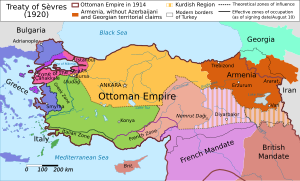

TheTreaty of Sèvreswas signed between the Allied and Associated Powers and Ottoman Empire atSèvres,Franceon 10 August 1920. The treaty included a clause on Armenia: it made all parties signing the treaty recognize Armenia as a free and independent state. The drawing of definite borders was, however, left to U.S. PresidentWoodrow Wilsonand the United States State Department, and was only presented to Armenia on 22 November 1920. The new borders gave Armenia access to the Black Sea and awarded large portions of the eastern provinces of the Ottoman Empire to the republic.[120]: 40–44
The Treaty of Sèvres was signed by the Ottoman Government, but SultanMehmed VInever signed it and thus never came into effect. TheTurkish Revolutionaries,led byMustafa Kemal Pasha,began theTurkish National Movementwhich, in opposing any territorial concessions to either the Greeks or the Armenians.[citation needed]
Turkish and Soviet Invasion
This sectionrelies largely or entirely on asingle source.(December 2015) |

On 20 September 1920, Turkish nationalist militants invaded the region ofSarikamish.[121]In response, Armenia declared war on Turkey on 24 September and theTurkish invasion of Armenia (1920)began. In the regions ofOltu,Sarikamish,Kars,andAlexandropol(Gyumri), Armenian forces clashed with those of the Turkish armies.Mustafa Kemal Pashahad sent several delegations to Moscow in search of an alliance, where he had found a receptive response by the Soviet government, which started sending gold and weapons to theTurkish revolutionaries,which would prove disastrous for the Armenians.[citation needed]
Armenia gave way tocommunistpower in late 1920. In November 1920, theTurkish revolutionariescaptured Alexandropol and were poised to move in on the capital. A cease fire was concluded on 18 November. Negotiations were then carried out betweenKâzım Karabekirand a peace delegation led byAlexander Khatisianin Alexandropol; although Karabekir's terms were extremely harsh the Armenian delegation had little recourse but to agree to them. TheTreaty of Alexandropolwas signed on 3 December 1920, although the Armenian government had already fallen to the Soviets the day before.[122]

As the terms of defeat were being negotiated, BolshevikGrigoriy Ordzhonikidzeinvaded from Azerbaijan the First Republic of Armenia in order to establish a new pro-Bolshevik government in the country. The11th Red Armybegan its virtually unopposed advance into Armenia on 29 November 1920 atIjevan.The actual transfer of power took place on 2 December 1920 in Yerevan.[123]
The Armenian leadership approved an ultimatum presented to it by the Soviet plenipotentiaryBoris Legran.Armenia decided to join the Soviet sphere, while Soviet Russia agreed to protect its remaining territory from the advancing Turkish army. The Soviets also pledged to take steps to rebuild the army, protect the Armenians and to not pursue non-communist Armenians, although the final condition of this pledge was reneged when the Dashnaks were forced out of the country.[124]
On 5 December, the Armenian Revolutionary Committee (Revkom,made up of mostly Armenians from Azerbaijan) also entered the city.[125]Finally, on the following day, 6 December,Felix Dzerzhinsky'sChekaentered Yerevan, thus effectively ending the existence of the Democratic Republic of Armenia. At that point what was left of Armenia was under the influence of theBolsheviks.[citation needed]
Although the Bolsheviks succeeded in ousting the Turks from their positions in Armenia, they decided to establish peace with Turkey. In 1921, the Bolsheviks and the Turks signed theTreaty of Kars,in which Turkey cededAdjarato the USSR in exchange for the Kars territory (today the Turkish provinces ofKars,Surmalu,andArdahan). The land given to Turkey included the ancient city ofAniandMount Ararat,the spiritual Armenian homeland. In 1922, the newly proclaimedArmenian Soviet Socialist Republic,under the leadership ofAlexander Miasnikyan,became part of the Soviet Union as one of three republics comprising theTranscaucasian SFSR.[123]
Armenian Soviet Socialist Republic (1922–1991)
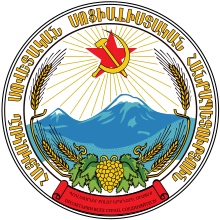
The Transcaucasian SFSR was dissolved in 1936, and as a result Armenia became a constituent republic of the Soviet Union as theArmenian Soviet Socialist Republic.[126]The transition tosocialismwas difficult for Armenia, and for most of the other republics in the Soviet Union. The Soviet authorities placed Armenians under supervision. The rate offreedom of speechwas considered low, even less so during secretaryship ofJoseph Stalin.Any individual who was suspected of using or introducingnationalist,racistandconservativerhetoricor elements in their works were labelled traitors or propagandists, and were sent toprisonsinSiberia.EvenZabel Yesayan,a writer who was fortunate enough to escape from ethnic cleansing during the Armenian genocide, was quickly exiled to Siberia after returning to Armenia from France.
ArmenianSSRparticipated inWorld War IIby sending hundreds of thousands of soldiers to the front line in order to defend the USSR.Marxist–Leninistsystem had several positive aspects. Armenia benefited from the Soviet economy, especially when it was at its apex. Provincial villages gradually became towns and towns gradually became cities. Peace between Armenia andAzerbaijanwas reached, albeit temporarily. During this time, Armenia had a sizeable Azeri minority, mostly centred in Yerevan. Likewise, Azerbaijan had an Armenian minority, concentrated inBakuandKirovabad.
Many Armenians still had nationalist and conservative sentiments, even though they were discouraged from expressing them publicly. On 24 April 1965, tens of thousands of Armenians flooded the streets of Yerevan to remind the world of the horrors that their parents and grandparents endured during the Armenian genocide of 1915. This was the first public demonstration of such high numbers in the USSR, which defended national interests rather than collective ones. In the late 1980s, Armenia was suffering from pollution. WithMikhail Gorbachev's introduction ofglasnostandperestroika,public demonstrations became more common. Thousands of Armenians demonstrated in Yerevan because of the USSR's inability to address simple ecological concerns. Later on, with the conflict inKarabakh,the demonstrations obtained a more nationalistic flavour. Many Armenians began to demandstatehood.
In 1988, theSpitak earthquakekilled tens of thousands of people and destroyed multiple towns in northern Armenia, such as Leninakan (modern-dayGyumri) andSpitak.Many families were left without electricity and running water. The harsh situation caused by the earthquake and subsequent events made many residents of Armenia leave and settle inNorth America,Western EuropeandAustralia.
On 20 February 1988, interethnic fighting between the ethnic Armenians of Nagorno-Karabakh and Azerbaijanis broke out shortly after the parliament ofNagorno-Karabakh,an autonomous oblast in Azerbaijan, voted to unify the region with Armenia. TheFirst Nagorno-Karabakh Warpitted Armenians of Nagorno-Karabakh, backed by Armenia, against theArmy of Azerbaijan.
Independent Armenia (from 1991)


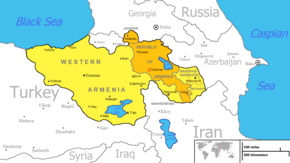
Orange: areas overwhelmingly populated by Armenians (Republic of Armenia: 98%;[127]Nagorno-Karabakh: 99%; Javakheti: 95%)
Yellow: Historically Armenian areas with presently no or insignificant Armenian population (Western Armenia and Nakhichevan)
Armenia declared itsindependencefrom the Soviet Union on 23 August 1990.[128]Independence was confirmed byreferendumon 21 September 1991. However, widespread recognition did not occur until the formal dissolution of the Soviet Union on 25 December 1991.
Armenia faced many challenges during its first years as asovereign state.Several Armenian organizations from around the world quickly arrived to offer aid and to participate in the country's early years. From Canada, a group of young students and volunteers under theCYMA - Canadian Youth Mission to Armeniabanner arrived in Ararat Region and became the first youth organization to contribute to the newly independent Republic.
Following the Armenian victory in theFirst Nagorno-Karabakh War,both Azerbaijan andTurkeyclosed their borders and imposed a blockade which they retain to this day, severely affecting the economy of the fledgling republic. In October 2009 Turkey and Armenia signed a treaty to normalize relations.
Ter-Petrosyan Presidency (1991–1998)

Levon Ter-Petrosyanwas popularly elected the first President of the newly independent Republic of Armenia on 16 October 1991 and re-elected on 22 September 1996.[129]His re-election was marred by allegations of electoral fraud reported by the opposition and supported by many international observers. His popularity waned further as the opposition started blaming him for the economic quagmire that Armenia's post-Soviet economy was in. He was also unpopular with one party in particular, theArmenian Revolutionary Federation,which he banned and jailed on the grounds that the party had a foreign-based leadership—something which was forbidden according to the Armenian Constitution.
Ter-Petrosyan was forced to step down in February 1998 after advocating compromised settlement of the conflict overNagorno-Karabakhwhich many Armenians regarded as undermining their security. Ter-Petrosyan's key ministers, led by then-Prime MinisterRobert Kocharyan,refused to accept a peace plan for Karabakh put forward by international mediators in September 1997. The plan, accepted by Ter-Petrosyan and Azerbaijan, called for a "phased" or "step-by-step" settlement of the conflict which would postpone an agreement on Nagorno-Karabakh's status, the main stumbling block. That agreement was to accompany the return of mostArmenian-occupied Azerbaijani territories around Nagorno-Karabakhand the lifting of the Azerbaijani and Turkish blockades of Armenia.[citation needed]In January 1998, Ter-Petrosyan's ministers forced Ter-Petrosyan to resign.[130]
Kocharyan Presidency (1998–2008)

After the resignation of his predecessorLevon Ter-Petrosyan,Robert Kocharyanwas elected Armenia's second President on 30 March 1998, defeating his main rival,Karen Demirchyan,in anearly presidential election marred by irregularities and violationsby both sides as reported by international electoral observers. Complaints included that Kocharyan had not been an Armenian citizen for ten years as required by the constitution.[131]In early 1998, Kocharyan rejected the 1997 OSCE Minsk Group peace plan and initiated a new phase of Nagorno-Karabakh negotiations, where Heydar Aliyev and Kocharyan negotiated secret from their publics and senior officials. In 1999, they orally agreed to a land swap that would annex Nagorno-Karabakh to Armenia in exchange for a strip of land connecting Azerbaijan and its exclave of Nakhichvan along the Iranian-Armenian border. In the fall of that year, Aliyev and Kocharyan informed the Minsk Group Co-Chairs of their plan and asked them to put it in writing.[130]
Weeks later, several opposition leaders in the Armenian Parliament and the Prime Minister of Armenia were killed by gunmen in an episode known as the1999 Armenian parliament shooting.Kocharyan himself negotiated with terrorists to lease the MP hostages. It is widely believed by Armenians at large that Kocharyan is responsible for the parliament shooting.[132][133]Thereafter, Kocharyan informed the Minsk Group that he was not able to support the peace deal anymore.[130]
The2003 Armenian Presidential electionwere held on 19 February and on 5 March 2003. No candidate received a majority in the first round of the election with theincumbentPresident Kocharyan winning slightly under 50% of the vote. Therefore, a second round was held and Kocharyan defeatedStepan Demirchyanwith official results showed him winning just over 67% of the vote. In both rounds, electoral observers from theOSCEreported significant amounts ofelectoral fraudby Demirchyan's supporters and numerous supporters of Demirchyan were arrested before the second round took place.[134]
Demirchyan described the election as having been rigged and called on his supporters to rally against the results.[135]Tens of thousands of Armenians protested in the days after the election against the results and called on President Kocharyan to step down.[134]Kocharyan was sworn in for a second term in early April and theconstitutional courtupheld the election, while recommending that areferendumbe held within a year to confirm the election result.[13][14]

As President, Kocharyan continued to negotiate a peaceful resolution with Azerbaijani PresidentIlham Aliyevon the status of Nagorno-Karabakh. Talks between Aliyev and Kocharyan were held in September 2004 inAstana,Kazakhstan,on the sidelines of theCISsummit. Reportedly, one of the suggestions put forward was the withdrawal of Armenian forces from the Azeri territories adjacent to Nagorno-Karabakh, and holdingreferendums(plebiscites) in Nagorno-Karabakh and Azerbaijan proper regarding the future status of the region. On 10–11 February 2006, Kocharyan and Aliyev met inRambouillet,Franceto discuss the fundamental principles of a settlement to the conflict, including the withdrawal of troops, formation of international peace keeping troops, and the status of Nagorno-Karabakh.[136]
Contrary to the initial optimism, the Rambouillet talks did not produce any agreement, with key issues such as the status of Nagorno-Karabakh and whether Armenian troops would withdraw fromKalbajarstill being contentious. The next session of the talks was held in March 2006 inWashington, D.C.[136]Russian PresidentVladimir Putinapplied pressure to both parties to settle the disputes.[137]No progress arose from further meetings in Minsk and Moscow in November 2006.[138]
Sargsyan Presidency (2008-2018)
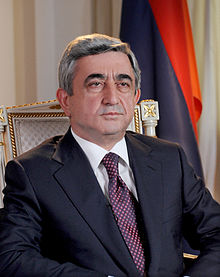
Serzh Sargsyan,thenPrime Minister of Armeniaand having President Kocharyan's backing, was viewed as the strongest contender for the post of the President of Armenia in theFebruary 2008 presidential election.[139][140]
Ter-Petrosyan officially announced his candidacy in the2008 presidential electionin a speech in Yerevan on 26 October 2007. He accused Kocharyan's government of massive corruption, involving the theft of "at least three to four billion dollars" over the previous five years. He was critical of the government's claims of strong economic growth and argued that Kocharyan and his Prime Minister,Serzh Sargsyan,had come to accept a solution to the problem ofNagorno-Karabakhthat was effectively the same solution that he had proposed ten years earlier. A number of opposition parties have rallied behind him since his return to the political arena, including thePeople's Party of Armenia,led byStepan Demirchyan;the Armenian Republic Party, led byAram Sargsyan;[141]theSocial Democrat Hunchakian Party;Azadakrum,led byJirair Sefilian;theNew Times Party;and theHeritage Party,led byRaffi Hovannisian.[142]

Final results from the election, which was held on 19 February 2008, officially showed Sargsyan winning about 53% of the vote, and Ter-Petrosyan in second place with 21.5% of the vote.[143]
Ter-Petrosyan and his supporters accused the government of rigging the election and claimed victory;[144]beginning 20 February, he ledcontinuous protestsinvolving tens of thousands of his supporters in Yerevan.[145]
On the early morning of 1 March, reportedly acting on evidence of firearms in the camp, the authorities moved in to inspect the tents set up by demonstrators. Law enforcement agents then violently dispersed the hundreds of protestors camped in. Ter-Petrosyan was placed under de facto house arrest, not being allowed to leave his home, though the authorities later denied the allegations.[146]
A few hours later, tens of thousands of protestors or more gathered at Miyasnikyan Square to protest the government's act. Police, overwhelmed by the sheer size of the crowd, pulled out. A state of emergency was implemented by President Kocharyan at 5 p.m., allowing the army to be moved into the capital. By nightfall, a few thousand protesters had barricaded themselves using commandeered municipal buses. As a result of skirmishes with the police, ten people died, including policemen.[147][148]
This was followed by mass arrests and purges of prominent members of the opposition, as well as ade facto banon any further anti-government protests. Sargsyan was recognized as legitimate president[149][150]
On 10 October 2009, the Turkish-Armenian protocols on the establishment of diplomatic relations constituted a novelty in Turkish-Armenian relations. Sargsyan accepted the proposal of studying the issue of the Armenian genocide through a commission, and recognized the current Turkish-Armenian border. In 2009–10, the Azerbaijan's military build-up along with increasing war rhetoric and threats risked causing renewed problems in theSouth Caucasus.[151]
In 2011,protestserupted in Armenia as part of therevolutionary wavesweepingthrough theMiddle East.Protesters continue to demand an investigation into the 2008 violence, the release of political prisoners, an improvement in socioeconomic conditions, and the institution of democratic reforms. TheArmenian National CongressandHeritagehave been influential in organizing and leading protests.[152]
Between 1 and 5 April 2016, there were renewed clashes between Armenian and Azerbaijani armed forces. (see2016 Armenian–Azerbaijani clashes).
In March 2018, Sargsyan was re-elected Prime Minister, despite opposition protests.[153]After military forces joined the protests on 23 April, Sargsyan resigned his position.[154][155]Former Prime MinisterKaren Karapetyansucceeded Sargsyan as acting Prime Minister.
Nikol Pashinyan Premiership (2018-present)

In March 2018, Armenian parliament electedArmen Sarkissianas the new President of Armenia. The controversial constitutional reform to reduce presidential power was implemented, while the authority of the prime minister was strengthened.[156]In May 2018, parliament elected opposition leaderNikol Pashinyanas the new prime minister. His predecessor Serzh Sargsyan resigned two weeks earlier following widespread anti-government demonstrations.[157]
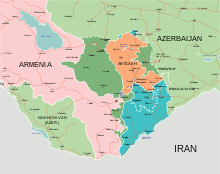
On 27 September 2020, afull-scale warerupted due to the unresolved Nagorno-Karabakh conflict. Both the armed forces of Armenia and Azerbaijan reported military and civilian casualties.[158]Aceasefire agreementwas signed on 10 November, in which theoccupied territories surrounding Nagorno-Karabakhwere handed over to Azerbaijan.Protestswere held in Armenia over this and hundreds stormed the Parliament building in Yerevan. Protests continued throughout November, with demonstrations in Yerevan and other cities demanding the resignation of Pashinyan.[159]
On 25 February 2021, The Armenian military called for Pashinyan to resign. The declaration, which Pashinyan described as acoup attempt,caused a political crisis that ended with the Chief of the General Staff of the Armenian Armed ForcesOnik Gasparyan's dismissal.[160][161]On 25 April 2021, Pashinyan announced his formal resignation from his post of prime minister to allow snap parliamentary elections in June. He continued to act as interim prime minister in the leadup to the election.[162]His party won the2021 election,receiving more than half of all votes. Nikol Pashinyan was officially appointed Armenia's prime minister.[163]On 23 January 2022, Armen Sarkissian left the office, saying the constitution does not any more give the president sufficient powers to influence.[164]On 3 March 2022,Vahagn Khachaturyanwas elected as the fifth president of Armenia in the second round of parliamentary vote.[165]
See also
- Armenian Resistance During the Armenian Genocide
- Dissolution of the Soviet Union
- History of Georgia (country)
- History of Iran
- History of Nagorno-Karabakh
- History of Russia
- History of the Caucasus
- History of Western Asia
- List of Armenian Kings
- List of Armenian territories and states
- List of Patriarchs of Armenia
- Politics of Armenia
- President of Armenia
- Timeline of Armenian history
- Timeline of Armenian national movement
- Timeline of modern Armenian history
- Zakarid Armenia
References
Citations
- ^abc"Armenian Rarities Collection".www.loc.gov.Washington, D.C.:Library of Congress.2020.Archivedfrom the original on 7 March 2023.Retrieved27 March2023.
The lands of theArmenianswere for millennia located inEastern Anatolia,on theArmenian Highlands,and into theCaucasus Mountain range.First mentioned almost contemporaneously by a Greek and Persian source in the 6th century BC, modern DNA studies have shown thatthe people themselves had already been in place for many millennia.Those people the world know as Armenians call themselvesHayand their countryHayots' ashkharh–the land of the Armenians, today known as Hayastan. Their language,Hayeren(Armenian) constitutes a separate and unique branch of theIndo-European linguistic family tree.A spoken language untilChristianity became the state religionin 314 AD,a unique alphabet was createdfor it in 407, both for the propagation of the new faith and to avoid assimilation into thePersian literary world.
- ^Moses of Chorene,The History of Armenia,Book 1, Ch. 12(in Russian)
- ^Kurkjian, Vahan (196).History of Armenia.Michigan.
- ^Armenian Soviet Encyclopedia,v. 12, Yerevan 1987;Artak Movsisyan"Sacred Highland: Armenia in the spiritual conception of the Near East", Yerevan, 2000.
- ^Katsenelinboĭgen, Aron (1990).The Soviet Union: Empire, Nation and Systems.New Brunswick: Transaction Publishers. p. 143.ISBN0-88738-332-7.
- ^R.D. Barnett (1982)."Urartu".In John Boardman; I.E.S. Edwards; N.G.L. Hammond; E. Sollberger (eds.).The Cambridge Ancient History, Vol. 3, Part 1: The Prehistory of the Balkans, the Aegean World, Tenth to Eighth Centuries BC(2nd ed.). Cambridge University Press. p. 346.ISBN978-0521224963.
- ^Toumanoff, Cyril(1963).Studies in Christian Caucasian history.Washington D.C.: Georgetown University Press. pp. 278ff.
- ^Tiratsyan, Gevorg.«Երվանդունիներ»(Yerevanduniner).Armenian Soviet Encyclopedia.vol. iii. Yerevan:Armenian Academy of Sciences,1977, p. 640.(in Armenian)
- ^Hovannisian, Richard G. (2004).The Armenian People From Ancient to Modern Times, Volume I: The Dynastic Periods: From Antiquity to the Fourteenth Century.Palgrave Macmillan. p. 49.ISBN1-4039-6421-1.
- ^"Landmarks in Armenian history".Internet Archive.Retrieved22 June2010."1080 A.D. Rhupen, cousin of the Bagratonian kings, sets up on Mount Taurus (overlooking the Mediterranean Sea)the kingdom of New Armeniawhich lasts 300 years. "
- ^abEastern Europe, Russia and Central Asia 2003.Taylor & Francis. 2000.ISBN9781857431377.Retrieved26 December2014.
- ^Peimani, Hooman (2009).Conflict and Security in Central Asia and the Caucasus.Abc-Clio.ISBN9781598840544.Retrieved26 December2014.
- ^ab"Armenia: President Sworn in Amid Protests".The New York Times.10 April 2003.Retrieved23 May2009.
- ^ab"Constitutional court stirs Armenian political controversy".Eurasianet.org.23 April 2003.Retrieved23 May2009.
- ^Croissant, Michael P. (1998).The Armenia-Azerbaijan Conflict: Causes and Implications.London: Praeger.ISBN978-0-275-96241-8.
- ^"Stone Tool Discovery in Armenia Gives Insight into Human Innovation 325,000 Years Ago".sci-news.com. 27 September 2014.
- ^"The first leather shoe".CNN. Archived fromthe originalon 26 September 2010.Retrieved15 November2007.
- ^"5,900-year-old women's skirt discovered in Armenian cave".News Armenia.13 September 2011. Archived fromthe originalon 10 October 2017.Retrieved14 September2011.
- ^"The first wine-making facility in Armenia".National Geographic.Archived fromthe originalon 12 January 2011.Retrieved15 November2007.
- ^Joan Aruz, Sarah B. Graff, Yelena Rakic,Cultures in Contact: From Mesopotamia to the Mediterranean in the Second Millennium B.C.The Metropolitan Museum of art symposia. Metropolitan Museum of Art, 2013ISBN1588394751pp. 12-24
- ^Aynur Özifirat (2008),The Highland Plateau of Eastern Anatolia in the Second Millennium BC: Middle/Late Bronze Agespp.103–106
- ^John A. C. Greppin and I. M. Diakonoff,Some Effects of the Hurro-Urartian People and Their Languages upon the Earliest ArmeniansJournal of the American Oriental Society Vol. 111, No. 4 (Oct. – Dec. 1991), pp. 721[1]
- ^Joan Aruz, Kim Benzel, Jean M. Evans,Beyond Babylon: Art, Trade, and Diplomacy in the Second Millennium B.C.Metropolitan Museum of Art (New York, N.Y.)[2](2008) pp. 92
- ^Kossian, Aram V. (1997),The Mushki Problem Reconsideredpp. 254
- ^Daniel T. PottsA Companion to the Archaeology of the Ancient Near East.Volume 94 of Blackwell Companions to the Ancient World. John Wiley & Sons, 2012ISBN1405189886p. 681
- ^Simonyan, Hakob Y. (2012)."New Discoveries at Verin Naver, Armenia".Backdirt(The Puzzle of the Mayan Calendar). The Cotsen Institute of Archaeology at UCLA: 110–113.
- ^Martirosyan, Hrach (2014)."Origins and Historical Development of the Armenian Language"(PDF).Leiden University. pp. 1–23.Archived(PDF)from the original on 9 October 2022.
- ^Archi, Alfonso (2016)."Egypt or Iran in the Ebla Texts?".Orientalia.85:3.
- ^Kroonen, Guus; Gojko Barjamovic; Michaël Peyrot (9 May 2018)."Linguistic supplement to Damgaard et al. 2018: Early Indo-European languages, Anatolian, Tocharian and Indo-Iranian".Zenodo:3.doi:10.5281/zenodo.1240524.
{{cite journal}}:CS1 maint: multiple names: authors list (link) - ^Martiros Kavoukjian, "The Genesis of Armenian People", Montreal, 1982.
- ^Armen Petrosyan.The Indo-European and Ancient Near Eastern Sources of the Armenian Epic.Journal of Indo-European Studies.Institute for the Study of Man. 2002. p. 184.[3]
- ^Armen Petrosyan.The Indo-European and Ancient Near Eastern Sources of the Armenian Epic.Journal of Indo-European Studies.Institute for the Study of Man. 2002. pp. 166-167.[4]
- ^International Standard Bible Encyclopedia, 1915[5]Archived21 February 2012 at theWayback Machine;Eric H. Cline and David O'Connor (eds.)Thutmose III,University of Michigan, 2006;ISBN978-0-472-11467-2.
- ^"The Longest Rivers in Armenia".21 December 2020.
- ^"Ancient Near East Chronology".Archived fromthe originalon 19 February 2007.Retrieved6 February2007.
- ^ab"Urartu/Armenia".Archived fromthe originalon 3 May 2015.Retrieved6 February2007.
- ^"Transanatolie – Kings of Urartu".Retrieved6 February2007.
- ^"ArcImaging (Archeological Imaging Research Consortium)".Retrieved6 February2007.
- ^Kurdoghlian, Mihran (1994).Badmoutioun Hayots, Volume I(in Armenian). Hradaragoutioun Azkayin Oussoumnagan Khorhourti. pp. 46–48.
- ^"History of Armenia in brief".EtnoArmenia Tours(in Italian).Retrieved22 April2024.
- ^Barbara A. West.Encyclopedia of the Peoples of Asia and OceaniaInfobase Publishing, 1 January 2009;ISBN1438119135,p. 50
- ^Redgate, Elizabeth (1998).The Armenians.Blackwell Publishing. pp. 65–68.
- ^Fuller, J.F.C. (1991).Julius Caesar: Man, Soldier, and Tyrant.Da Capo Press. p.45.ISBN0-306-80422-0.
- ^Armenia Country Study Guide Volume 1 Strategic Information and Developments.International Business Publications, USA. September 2013.ISBN9781438773827.[permanent dead link]
- ^Migliorati, Guido (2003).Cassio Dione e l'impero romano da Nerva ad Antonino Pio.Vita e Pensiero.ISBN9788834310656.
- ^Vahan Kurkjian: Armenia and the Romans
- ^"The Parthian Period".Retrieved6 February2007.
- ^HA Marcus Antoninus 9.1, Verus 7.1; Dio Cass. 71.3.
- ^"Armenia: History".Archived fromthe originalon 28 February 2007.Retrieved6 February2007.
- ^"Church of Armenia".Archived fromthe originalon 28 January 2007.Retrieved6 February2007.
- ^Eastmond, Antony (2003).""Local" Saints, Art, and Regional Identity in the Orthodox World after the Fourth Crusade ".Speculum.78(3): 740, Fig.11.doi:10.1017/S0038713400131525.ISSN0038-7134.JSTOR20060787.
- ^"Church of Saint Gregory of Tigran Honents in Ani".Turkish Archaeological News.10 December 2023.
- ^Nersessian, Vrej (2001).Treasures from the Ark: 1700 Years of Armenian Christian Art.The British Library Board - Getty Museum. p. 193.
This episode had been represented in the Church of St Gregory at Ani, built by Grigor Honents, in 1215. The king, surrounded by his friends and his army, all on horseback, scts out to greet Gregory
- ^"Information about Armenia on nationalgeographic.com".Archived fromthe originalon 30 January 2007.Retrieved6 February2007.
- ^"Armenian Church History and Doctrine".Archived fromthe originalon 30 July 2009.Retrieved6 February2007.
- ^"The Holy City and the Mother Church of St. Etchmiadzin".Archived fromthe originalon 23 August 2017.Retrieved6 February2007.
- ^"Khor Virap Travel Guide".Archived fromthe originalon 30 September 2007.Retrieved6 February2007.
- ^Anheier, Helmut K.; Juergensmeyer, Mark (9 March 2012).Encyclopedia of Global Studies.SAGE Publications.ISBN9781412994224.Retrieved26 December2014.
- ^Mary Boyce.Zoroastrians: Their Religious Beliefs and Practices,Psychology Press, 2001;ISBN0415239028,p. 84
- ^"Armenian alphabet, pronunciation and language".Retrieved6 February2007.
- ^"The Sassanids, to 500 CE".Retrieved6 February2007.
- ^"Timeline – Armenia".Retrieved6 February2007.
- ^"Avarayr".Archived fromthe originalon 6 October 2007.Retrieved6 February2007.
- ^"Armenians".8 September 1987. Archived fromthe originalon 11 November 2001.Retrieved6 February2007.
- ^abHacikyan, Agop Jack;Basmajian, Gabriel; Franchuk, Edward S.; Ouzounian, Nourhan (2000).The Heritage of Armenian Literature: From the Oral Tradition to the Golden Age.Vol. 1. Detroit: Wayne State University Press. p.168.ISBN978-0-8143-2815-6.
- ^Dubov, Kalman (26 November 2021).Journey to the Republic of Armenia.Kalman Dubov. pp. 17–18.
- ^"Armenia - Marzpans, Provinces, Borders | Britannica".www.britannica.com.Retrieved26 April2024.
- ^Evans, Helen C. (2018).Armenia: Art, Religion, and Trade in the Middle Ages.Metropolitan Museum of Art. p. 34.ISBN978-1-58839-660-0.
- ^Vasiliev, Alexander A.(1958).History of the Byzantine Empire, 324–1453.University of Wisconsin Press.p.[6].ISBN9780299809256.
- ^Redgate, Anne Elizabeth (26 May 2000).Armenians.Wiley. p. 237.ISBN978-0-631-14372-7.
- ^"Basil I in Encyclopædia Britannica".Archived fromthe originalon 28 August 2011.Retrieved6 February2007.
- ^"Armenia Sacra"(PDF).Archived fromthe original(PDF)on 1 January 2011.Retrieved8 February2007.
- ^Clifford Edmund Bosworth,The New Islamic Dynasties,Columbia University (1996), pp. 148–49.
- ^V. Minorsky,Studies in Caucasian History,Cambridge University Press, 1957. pg 112
- ^Clifford Edmund Bosworth,The New Islamic Dynasties,pp. 148–149. "..their centres at Tarum and Samiran, and then in Azerbaijan and Arran..","..into Azerbaijan, Arran, some districts of Eastern Armenia and as far as Darband in the Caspian coast."
- ^Eastmond, Antony (2017).Tamta's World: The Life and Encounters of a Medieval Noblewoman from the Middle East to Mongolia.Cambridge University Press.doi:10.1017/9781316711774.ISBN9781316711774.
- ^"Alp Arslan".Archived fromthe originalon 4 March 2016.Retrieved6 February2007.
- ^"Byzantium and Its Influence on Neighboring Peoples".Retrieved8 February2007.
- ^abArmenia: Art, Religion, and Trade in the Middle Ages - MetPublications - The Metropolitan Museum of Art.Metropolitan Museum of Art. 2018. p. 32.
The devastation caused by the Mongols is recorded in the colophons of many manuscripts of the period. Some Armenians, however, prospered as allies of, and soldiers and merchants for, the Mongols, including the Zakarian, Orbelian, and Proshian families. They continued or extended their existing trade routes into China, now controlled by the Mongols. Examples of Proshian success are seen at the church of the White Virgin (Spitakavor Astuatsatsin) with its relief carving of Amir Hasan (cat. 35) and in the exquisite, richly gilded reliquary presented by his father (cat. 36).
- ^Bedrosian, Robert (2004). "Despite the serious shortcomings of life under the Mongols, for most of the thirteenth century Armenian culture developed freely. This was due as much to the generally free status of the church as to the largesse of the lords and merchants. In the thirteenth and early fourteenth century, there were a number of large monastic complexes where clerics were educated and where the many manuscripts surviving from this period were written, copied, and illuminated. Among the flourishing monasteries were Ayrivank. Sanahin, Haghbat, Nor Getik (Goshavank), Khoranashat, Kayenadzor, Khor Virap, Kecharuyk, and Gladzor.".The Armenian people from ancient to modern times(PDF)(1st pbk. ed.). New York: St. Martin's Press.ISBN978-1403964212.
- ^Mutafian, Claude (1993).Le Royaume Arménien de Cilicie.Paris: CNRS Editions. pp. 13–153.ISBN2-271-05105-3.
- ^Edwards, Robert W. (1987).The Fortifications of Armenian Cilicia: Dumbarton Oaks Studies XXIII.Washington, D.C.: Dumbarton Oaks, Trustees for Harvard University. pp. 3–282.ISBN0-88402-163-7.
- ^Edwards, Robert W., "Settlements and Toponymy in Armenian Cilicia", Revue des Études Arméniennes 24, 1993, pp.181-204.
- ^abc"Cilicia: A Historical Overview"(PDF).Archived fromthe original(PDF)on 14 June 2007.Retrieved8 February2007.
- ^"Page:Catholic Encyclopedia, volume 1.djvu/815 - Wikisource, the free online library".en.wikisource.org.Retrieved26 April2024.
- ^"Dangerous Archaeology".exhibitions.kelsey.lsa.umich.edu.Retrieved22 April2024.
- ^Suny, Ronald G. (1 April 1996).Armenia, Azerbaijan, and Georgia.DIANE Publishing. pp.11.ISBN9780788128134.
- ^Rayfield, Donald (15 February 2013).Edge of Empires: A History of Georgia.Reaktion Books.ISBN9781780230702.Retrieved15 December2014.
- ^Hewsen, Robert H. (2001).Armenia: a historical atlas.University of Chicago Press. p. 116.ISBN0-226-33228-4.
- ^Haxthausen, Baron August von(2016) [1854–55].Transcaucasia and the Tribes of the Caucasus.Translated by John Edward Taylor. Introduction by Pietro A. Shakarian. Foreword byDominic Lieven.London:Gomidas Institute.p. 176.ISBN9781909382312.
- ^Fisher et al. 1991,p. 332.
- ^Timothy C. DowlingRussia at War: From the Mongol Conquest to Afghanistan, Chechnya, and Beyondpp 728–729 ABC-CLIO, 2 December 2014.ISBN978-1598849486
- ^abMikaberidze, Alexander.Conflict and Conquest in the Islamic World: A Historical Encyclopedia 2 volumes: A Historical Encyclopedia,ABC-CLIO, 22 July 2011;ISBN978-1598843378,p. 351
- ^Fisher et al. 1991,pp. 329–330.
- ^Timothy C. Dowling,Russia at War: From the Mongol Conquest to Afghanistan, Chechnya, and Beyond,pp 729–30, ABC-CLIO, 2 December 2014;ISBN978-1598849486.
- ^Azarian, Haroot (2018)."Armenians in Iran: A Brief History"(PDF).www.odvv.org.Retrieved22 April2024.
- ^McCarthy, Justin.The Ottoman Peoples and the end of Empire;London, 1981; p. 63
- ^Arman J. Kirakossian.British Diplomacy and the Armenian Question: From the 1830s to 1914,p. 58
- ^ab"Hamidian massacres | Armenian Genocide, Ottoman Empire & Sultan Abdul Hamid II | Britannica".www.britannica.com.Retrieved22 April2024.
- ^Dowling, Timothy C. (2 December 2014).Russia at War: From the Mongol Conquest to Afghanistan, Chechnya, and Beyond...Abc-Clio.ISBN9781598849486.Retrieved22 December2014.
- ^Hovannisian, Richard G (1971)."Russian Armenia. A Century of Tsarist Rule".Jahrbücher für Geschichte Osteuropas.19(1): 31–48.JSTOR41044266– via JSTOR.
- ^Bournoutian, George A. (1982).Eastern Armenia in the Last Decades of Persian Rule, 1807–1828.Malibu: Undena Publications. pp. xxii, 165.
- ^The Cambridge History of Iran by William Bayne Fisher, Peter Avery, Ilya Gershevitch, Gavin Hambly, Charles Melville, Cambridge University Press, 1991, p. 339
- ^Potier, Tim (2001).Conflict in Nagorno-Karabakh, Abkhazia and South Ossetia: A Legal Appraisal.Martinus Nijhoff Publishers. p. 2.ISBN90-411-1477-7.
- ^Kieser, Hans-Lukas; Schaller, Dominik J. (2002),Der Völkermord an den Armeniern und die Shoah[The Armenian genocide and the Shoah] (in German), Chronos, p. 114,ISBN3-0340-0561-X
Walker, Christopher J. (1980),Armenia: The Survival of A Nation,London: Croom Helm, pp. 200–03
Bryce, Viscount James;Toynbee, Arnold (2000), Sarafian, Ara (ed.),The Treatment of Armenians in the Ottoman Empire, 1915–1916: Documents Presented to Viscount Grey of Falloden(uncensored ed.), Princeton,NJ:Gomidas, pp. 635–649,ISBN0-9535191-5-5 - ^
For example:
- Derderian, K. (1 March 2005). "Common Fate, Different Experience: Gender-Specific Aspects of the Armenian Genocide, 1915-1917".Holocaust and Genocide Studies.19(1): 1–25.doi:10.1093/hgs/dci001.ISSN8756-6583.PMID20684092.S2CID8142484.
the figure of 1.5 million people is generally accepted as a reasonable estimate
- "Tsitsernakaberd Memorial Complex".Armenian Genocide Museum-Institute.Retrieved17 June2016.
- Kifner, John(7 December 2007)."Armenian Genocide of 1915: An Overview".The New York Times.
- Derderian, K. (1 March 2005). "Common Fate, Different Experience: Gender-Specific Aspects of the Armenian Genocide, 1915-1917".Holocaust and Genocide Studies.19(1): 1–25.doi:10.1093/hgs/dci001.ISSN8756-6583.PMID20684092.S2CID8142484.
- ^Göçek, Fatma Müge (2015).Denial of violence: Ottoman past, Turkish present and collective violence against the Armenians, 1789–2009.Oxford University Press. p. 1.ISBN978-0-19-933420-9.
- ^Auron, Yair (2000).The banality of indifference: Zionism & the Armenian genocide.Transaction. p. 44.ISBN978-0-7658-0881-3.
- ^Forsythe, David P. (11 August 2009).Encyclopedia of human rights(Google Books).Vol. 1. Oxford University Press. p. 98.ISBN978-0-19-533402-9.
- ^Chalk, Frank Robert; Jonassohn, Kurt (10 September 1990).The history and sociology of genocide: analyses and case studies.Institut montréalais des études sur le génocide. Yale University Press. pp.270–.ISBN978-0-300-04446-1.
- ^Freedman, Jeri (2009).The Armenian genocide.New York: Rosen Pub. Group. p. 49.ISBN978-1-4042-1825-3.
- ^"Armenia - Caucasus, Soviet Union, Genocide | Britannica".www.britannica.com.Retrieved11 April2024.
- ^Artin H. Arslanian and Robert L. Nichols (1979)."Nationalism and the Russian Civil War: The Case of Volunteer Army-Armenian Relations, 1918-20".Soviet Studies.31(4): 559–573.doi:10.1080/09668137908411267.JSTOR150918– via JSTOR.
- ^ab"First Republic of Armenia 1918-1920".Armenian-History.com.Retrieved22 April2024.
- ^abChristopher Walker.Armenian the Survival of a Nation,pp. 267–68
- ^Boeschoten, Hendrik; Rentzsch, Julian (2010).Turcology in Mainz.Otto Harrassowitz Verlag. p. 142.ISBN978-3-447-06113-1.
- ^See Hovannisian.Republic of Armenia, Vol. II,p. 192, map 4.
- ^Hovannisian.Republic of Armenia, Vol. I,pp. 243–47.
- ^Paris. Peace conference, 1919 Armenia [from old catalog (1919).The Armenian question before the Peace conference.The Library of Congress. [New York, Press Bureau, The Armenian National Union of America.
{{cite book}}:CS1 maint: numeric names: authors list (link) - ^Hovannisian, Richard G.(1996b).The Republic of Armenia: Between Crescent and Sickle: Partition and Sovietization.Vol. 4. Berkeley:University of California Press.ISBN978-0520088047.
- ^Hovannisian.Republic of Armenia, Vol. IV,pp. 184–97.
- ^Hovannisian.Republic of Armenia, Vol. IV,pp. 394–96.
- ^ab"Armenia - Caucasus, Soviet Union, Genocide | Britannica".www.britannica.com.Retrieved28 April2024.
- ^"History of Armenia by Vahan Kurkjian • Chapter 48".penelope.uchicago.edu.Retrieved28 April2024.
- ^Hovannisian.Republic of Armenia, Vol. IV,pp. 373ff.
- ^"History of Transcaucasia - Russian Penetration, Conflict, Caucasus | Britannica".www.britannica.com.Retrieved22 April2024.
- ^"2011 Census Results"(PDF).armstat.am.National Statistical Service of Republic of Armenia. p. 144.Archived(PDF)from the original on 9 October 2022.
- ^ARMENIAN DECLARATION OF INDEPENDENCE
- ^"Armenia - Independence, Caucasus, Soviet Union | Britannica".www.britannica.com.Retrieved11 April2024.
- ^abcRemler, Philip; Giragosian, Richard; Lorenzini, Marina; Rastoltsev, Sergei (2021), "OSCE Minsk Group: Lessons from the Past and Tasks for the Future",OSCE Insights 2020,Institute for Peace Research and Security Policy at the University of Hamburg, Nomos Verlagsgesellschaft mbH & Co. KG, pp. 1–15,doi:10.5771/9783748922339-06,ISBN978-3-7489-2233-9,S2CID234336533
- ^"Armenian president resigns"[permanent dead link],BBC.co.uk, 4 February 1998.
- ^Kaeter, Margaret (2004).The Caucasian republics.New York: Facts on File. pp.43–44.ISBN9780816052684.
However, political observers across the world speculate that Sarkissian was hoping to take a stronger position on the Nagorno-Karabakh issue than Kocharian liked. Many Armenians believe the shootings were the result of a conspiracy, in which Kocharian was involved. They note that some of Kocharian's main political rivals at the time were among those killed.
- ^Zürcher, Christoph[in German](2007).The post-Soviet wars: rebellion, ethnic conflict, and nationhood in the Caucasus.New York: New York University Press. p. 173.ISBN9780814797099.
He [Kocharian] is rumored to have been behind the gunning down of several of his opponents on the floor of the parliament in 1999.
- ^abStern, David (7 March 2003). "Anger at 'flawed' poll in Armenia".Financial Times.p. 4.
- ^"Incumbent 'wins' Armenia vote".BBC Online.6 March 2003.Retrieved23 May2009.
- ^ab"Drawing the Line: Maps meet principles in the search for a settlement over Nagorno Karabakh".ArmeniaNow.com. Archived fromthe originalon 26 September 2007.Retrieved10 December2015.
- ^"Putin Going to Invite Kocharyan to Moscow to Discuss Karabakh Issue"Archived6 October 2007 at theWayback Machine,yerkir.am, 23 February 2006.
- ^"Peter Semneby: EU tries to create trust between Karabakh and Azerbaijan" More than 4 bln dollars were stolen by his clan in Armenia, YERKIR.am, 21 February 2007.
- ^The Constitution of the Republic of Armenia (27 November 2005), Chapter 3: The President of the Republic, Article 50Archived15 October 2008 at theWayback Machine,president.am; accessed 10 December 2015.
- ^Helix Consulting LLC."ROBERT KOCHARYAN TO SUPPORT SERZH SARGSYAN".panorama.am.Retrieved10 December2015.
- ^Emil Danielian and Liz Fuller,"Armenian Ex-President Confirms Comeback Plans",Radio Free Europe/Radio Liberty, 1 November 2007.
- ^Payqar newspaperArchived10 March 2008 at theWayback Machine;accessed 10 December 2015.
- ^"Sargsyan wins Armenian presidential race",Xinhua, 20 February 2008.
- ^"Armenian opposition candidate accuses prime minister of election violations"Archived7 September 2008 at theWayback Machine,Associated Press (International Herald Tribune), 19 February 2008.
- ^"Thousands challenge victory of Armenian PM in presidential vote in 2nd day of protests"Archived15 October 2008 at theWayback Machine,International Herald Tribune,21 February 2008.
- ^"Ter-Petrosyan 'Under House Arrest', Rally Broken Up"Archived23 November 2008 at theWayback Machine,armenialiberty.org, March 2008; accessed 10 December 2015.
- ^"Armenia: Eight Killed After Clashes Between Police, Protesters",Radio Free Europe/Radio Liberty, 2 March 2008.
- ^"State of emergency declared in Armenia".RTÉ News.1 March 2008.Retrieved9 September2010.
- ^"Armenia: Police Beat Peaceful Protesters in Yerevan"Archived11 November 2008 at theWayback Machine,Human Rights Watch(NY), 2 March 2008.
- ^Ter-Petrosyan 'Under House Arrest,' Rally Broken UpArchived23 November 2008 at theWayback Machine,Radio Free Europe/Radio Liberty,1 March 2008.
- ^"Statement by President Serzh Sargsyan at the General Debate of the 63 rd session of the general assembly".President.am.25 September 2008. Archived fromthe originalon 17 October 2008.Retrieved11 April2009.
- ^"Armenia: Opposition Bypasses Police, Stages Rally in Freedom Square".EurasiaNet.org.Retrieved10 December2015.
- ^"Lawmakers Approve Sarkisian As Armenia's PM Despite Countrywide Protests".RadioFreeEurope/RadioLiberty.Retrieved17 April2018.
- ^"Armenian soldiers join anti-government protests in Yerevan".DailySabah.Retrieved23 April2018.
- ^"Armenian PM resigns after protests".BBC News.23 April 2018.Retrieved23 April2018.
- ^"Armenia: Armen Sarkissian elected into new, less powerful presidential role | DW | 02.03.2018".Deutsche Welle.
- ^"Pashinyan elected as Armenia's new prime minister".
- ^"Fighting over Nagorno-Karabakh goes on despite US mediation".Associated Press.24 October 2020.
- ^Rival Rallies In Yerevan As Armenia Reels From Nagorno-Karabakh Truce,retrieved21 November2020
- ^Child, David (25 February 2021)."Protests rock Armenia as PM slams 'coup' attempt: Live updates".Al Jazeera.
- ^"Armenia PM Nikol Pashinyan accuses army of attempted coup".BBC.25 February 2021.
- ^"Armenian Prime Minister Pashinyan announces his resignation to enable snap polls".France24.25 April 2021.Retrieved25 April2021.
- ^"Nikol Pashinyan officially appointed Armenia's prime minister".The New Indian Express.2 August 2021.
- ^"Armenian president resigns over lack of influence".www.aljazeera.com.
- ^"Vahagn Khachaturyan elected new Armenian president".www.aa.com.tr.
Books
- The Armenian People From Ancient to Modern Times: The Dynastic Periods: From Antiquity to the Fourteenth Century / Edited by Richard G. Hovannisian. — Palgrave Macmillan, 2004. — Т. I.
- The Armenian People From Ancient to Modern Times: Foreign Dominion to Statehood: The Fifteenth Century to the Twentieth Century / Edited by Richard G. Hovannisian. — Palgrave Macmillan, 2004. — Т. II.
- Nicholas Adontz,Armenia in the Period of Justinian: The Political Conditions Based on the Naxarar System,trans. Nina G. Garsoïan (1970)
- George A. Bournoutian,Eastern Armenia in the Last Decades of Persian Rule, 1807–1828: A Political and Socioeconomic Study of the Khanate of Erevan on the Eve of the Russian Conquest(1982)
- George A. Bournoutian,A History of the Armenian People,2 vol. (1994)
- Chahin, M. 1987.The Kingdom of Armenia.Reprint: Dorset Press, New York. 1991.
- Armen Petrosyan. "The Problem of Armenian Origins: Myth, History, Hypotheses (JIES Monograph Series No 66)," Washington DC, 2018
- I. M. Diakonoff,The Pre-History of the Armenian People(revised, trans. Lori Jennings), Caravan Books, New York (1984),ISBN0-88206-039-2.
- Fisher, William Bayne; Avery, P.; Hambly, G. R. G; Melville, C. (1991).The Cambridge History of Iran.Vol. 7. Cambridge:Cambridge University Press.ISBN0521200954.
- Luttwak, Edward N. 1976.The Grand Strategy of the Roman Empire: From the First Century A.D. to the Third.Johns Hopkins University Press. Paperback Edition, 1979.
- Lang, David Marshall.1980.Armenia: Cradle of Civilization.3rd Edition, corrected. George Allen & Unwin. London.
- Langer, William L.The Diplomacy of Imperialism: 1890–1902(2nd ed. 1950), a standard diplomatic history of Europe; see pp 145–67, 202–9, 324–29
- Louise Nalbandian,The Armenian Revolutionary Movement: The Development of Armenian Political Parties Through the Nineteenth Century(1963).
- Comprehensive list of historical documents relating to the treatment of Armenians in the Ottoman Empire
Publications
 This article incorporatespublic domain materialfromU.S. Bilateral Relations Fact Sheets.United States Department of State.
This article incorporatespublic domain materialfromU.S. Bilateral Relations Fact Sheets.United States Department of State.- "Armenia" in theCatholic Encyclopedia
- The Free Republic of Armenia 1918.Armenian National Committee, San Francisco. [1980].
- "The Crusaders through Armenian Eyes" by Robert W. Thomson, fromThe Crusades from the Perspective of Byzantium and the Muslim World,edited byAngeliki E. LaiouandRoy Parviz Mottahedeh(Dumbarton Oaks, 2001). Also accessible online at www.doaks.org/etexts.html
- Gasimov, Zaur (2011),The Caucasus,EGO - European History Online,Mainz:Institute of European History,retrieved: March 25, 2021 (pdf).
Films
- The Armenian Genocide — Director Andrew Goldberg. (During World War I, over 1,500,000 million Armenians died at the hands of the Ottoman Turks in death camps of Western Armenia and the Syrian Desert and 1,500,000 were forcibly islamized and turkified. Another 600,000 Armenians escaped to Eastern Armenia in Russian Empire). 2006
- Seven Songs About Armenia (Yot yerg Hayastani masin) – doc. Director Grigoriy Melik-Avagyan 1972
- Armenian Eyes (Haykakan achker), (documentary).1980 Ruben Gevorgyants
- The Manuscript of independence (Matyan Ankakhutyan) This film is dedicated to the 10th anniversary of independence of Armenia. Director Levon Mkrtchyan 2002
Primary sources
- Ghazar P'arpec'i,History of the Armenians and Letter to Vahan Mamikonean,trans. R. Bedrosian, (1985)
- Hacikyan, A. J. (Editor),The Heritage of Armenian Literature: From the Oral Tradition to the Golden Age(Heritage of Armenian Literature, vol. 1), (Detroit, 2000) [PK 8532.H47 2000 vol.1] [anthology of Armenian texts]
- Koriun,The Life of Mashtots,trans. B. Norehad, (New York: Caravan, 1985) [hagiography of the monk who invented the Armenian alphabet]
- Łewond,The History of Lewond,trans. Z. Arzoumanian, (Philadelphia, 1982) [History of the Arab conquest of Armenia, 7C-8C]
- Movses KhorenatsiMoses of Chorene,History of the Armenians (trans. R. Thomson, Harvard, 1978)
Further reading
- Galichian, Rouben(2014).Historic Maps of Armenia: The Cartographic Heritage.Print info. London.ISBN978-1-908755-20-9.OCLC893915777.
{{cite book}}:CS1 maint: location missing publisher (link) - Stopka, Krzysztof (2016).Armenia Christiana: Armenian Religious Identity and the Churches of Constantinople and Rome (4th–15th century).Kraków: Jagiellonian University Press.ISBN9788323395553.
- de Waal, Thomas.Black Garden.NYU (2003).ISBN0-8147-1945-7
- Khudaverdyan, Anahit Yu. "Palaeopathology of human remains of the 1st century BC–3rd century AD from Armenia (Beniamin, Shirakavan I)."Anthropological Review 78.2 (2015): 213–228.
External links
- Arak29 Origins of Armenian people (Arm.)Archived24 July 2020 at theWayback Machine
- Arak29 Origins of Armenian people (Eng.)Archived28 March 2020 at theWayback Machine
- History of Armenia(book byVahan Kurkjian)
- Armenia at Livius.OrgArchived3 May 2015 at theWayback Machine(ancient history)
- "History of Armenia, by Father Michael Chamich; from B. C. 2247 to the Year of Christ 1780, or 1229 of the Armenian Era",from 1827, via theWorld Digital Library
- Armenian Historical Sources(by Robert Bedrosian)
- Armenia and the Pontus(by Dicran E. Siramarc)
- Rulers.org — Armenialist of rulers for Armenia
- Background Note: Armenia
- Minasyan, Sergey: "Armenia's Attitude Towards its Past: History and Politics" in theCaucasus Analytical Digest No. 8
- Ter-Gabrielyan, Gevorg: "The Archeology of Future Literature: Digging out Prose from Independent Armenia's History" in theCaucasus Analytical Digest No. 14

